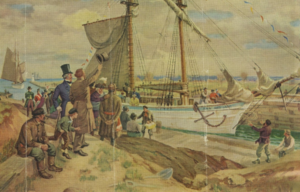Port Dalhousie Unlocked:
Port Dalhousie Unlocked:
The Opening of the Welland Canal in 1829
Lauren Jackson
Port2Port - 2025
On the crisp morning of November 30, 1829, after five years of challenging construction, a monumental event unfolded in the serene landscapes of Port Dalhousie, Ontario. The long-awaited First Welland Canal was officially opened, marking a transformative moment in the maritime history of the Great Lakes. This engineering marvel enabled vessels to bypass the formidable Niagara Falls, directly connecting the expansive waters of Lake Erie with Lake Ontario. Considered the northern terminus of the canal pictured in figure 1, Port Dalhousie would emerge as a pivotal maritime hub, fundamentally reshaping the economic and cultural landscape of Upper Canada.1

Figure 1: The Opening of the First Welland Canal in November 1829, Lock 1, Port Dalhousie.
In the Welland Canal Company's Annual Report of 1830, it highlights the transformative impact Port Dalhousie played as the canal's northern terminus. The report emphasized that successful navigation was fully tested during the latter part of the season by the passage of several vessels. Port Dalhousie quickly became a key point for the transfer and movement of goods.2 As vessels bypassed Niagara Falls, the report noted that Port Dalhousie's strategic location positioned it to facilitate the booming trade between Lake Erie and Lake Ontario, cementing its role as a bustling hub in the growing maritime economy of Upper Canada.
The opening of the Welland Canal sparked an economic boom that transformed Port Dalhousie from a small fishing village into a thriving port town. The Welland Canal effectively turned the Great Lakes into an inland water highway, facilitating the trade of lumber, coal, and grain.3 Without a doubt, Port Dalhousie was the most important port on the lake. Every vessel bound to or from the Upper Lakes is obligated to pass through the Welland Canal and, consequently, to enter or leave this port. It has the advantage of being easily made in any weather and with any wind.4
By 1833, modifications had been made to the canal to expand to make more direct routes to the other surrounding ports. It now stretched 43.4 kilometers long from Port Dalhousie to Port Colborne and was 2.4 meters deep, consisting of 40 wooden locks.5 Builders consisted of European immigrants placed in labour-intensive areas, with picks and shovels, getting paid half a dollar per day. Costing over 8 million dollars, equating to 250-300 million today, this project was the awakening of a flourishing of infrastructure.
In the wake of the canal's opening, the waterfront sprang to life with shipyards, businesses, and warehouses, each adapting to accommodate the steady stream of incoming ships and cargo. The establishment of shipyards in Port Dalhousie was a direct consequence of the canal's operational success, leading to a boom in shipbuilding and repair services.6 This surge in industrial activity provided employment opportunities for shipbuilding and repair services. Additionally, jobs were created in warehousing, businesses supporting the port's infrastructure, and industries that catered to the increasing shipping traffic, such as dockworkers, tradespeople, and labourers involved in handling cargo and maintaining the canal.
The opening of the Welland Canal not only transformed Port Dalhousie into a bustling economic center but also fostered a vibrant and diverse community where maritime trade and cultural exchange flourished. As ships passed through the canal, they carried not just goods but ideas and traditions, creating a dynamic port town where local life revolved around the rhythms of the water. This legacy of maritime commerce and cultural integration would continue to shape the region for decades, solidifying Port Dalhousie's place as a key player in Canada's early economic and social development.
-
Figure 1: [Schooner Ann and Jane, at lock 1, the day the First Welland Canal opened], painting by J.D. Kelly, Alpena County George N. Fletcher Library, n.d. ↩
-
John H. Dunn, An Extra Report of the Board of Directors of the Welland Canal Company, Welland Canal Company, Jun. 6, 1829. ↩
-
John Jackson, The Welland Canals and their Communities: Engineering, Industrial, and Urban Transformation (Toronto: University of Toronto Press, 1997) 58. ↩
-
Edward Hodder, The Harbours and Ports of Lake Ontario (Toronto: Maclear & Co., 1857) 23. ↩
-
Unknown Author, Brief History, wellandcanal.com, n.d. ↩
-
Jackson, "The Welland Canals and Their Communities," 75. ↩

